Take guidance for a deck that will last for decades and leave you free to kick back with a coldie.
The outdoor timber deck is one of the icons of Australiana. In our temperate climate it is the go-to area to be with family and friends. The smell of the BBQ cooking, drinks flowing, noisy discussions and laughter… Ahh, I better keep writing or I might end up on the back deck myself.
Decks come in all shapes and sizes and there are a number of things to consider when designing/building a deck to make sure it stays a safe and enjoyable space. This article runs through what to consider all the way from design to continuing maintenance and focuses on points people miss that can make the difference to getting a perfect deck. The first place to start is the design. Deck loads are set out in AS 1720.3-2016 and all common design programs have options available for both dead and live loads. Ensure you take into account heavy loads like planter boxes and if the deck is more than 1m above the ground, the live load needs to be 2kPa/1.8kN.
Another decision which is needed in the design stage is material choice. Common bearer, joist and decking board materials are treated pine, primed pine, merbau or native hardwoods. The joist spacing will be governed by board thickness but is typically 450mm centres using 22mm-thick deck boards. When selecting the material be aware of any other factors such as bushfire attack level (BAL) ratings. These could force the members into bushfire resisting materials or specifically tested systems, noting that all decks in NSW BAL 12.5- and BAL 19-rated areas need to be designed to BAL 29 requirements.
Durability and detailing are an extremely important part of deck design if using timber decking boards rather than solid flooring like lightweight fibre cement sheets. For long-term performance the timbers should either be naturally durable or preservative treated to H3 (outside, above ground). Detailing of connections is one area of deck design where not enough attention is paid. Contact points between timber should be free draining to prevent trapped moisture which will lead to decay and rot. Depending on the environment you could consider capping the top of the bearers (and/or joists). And if using joist hangers make sure they have the right level of protection against corrosion. Areas closer to salt spray require higher performance hangers such as stainless steel. Although a builder might baulk at the initial cost, it is a drop in the ocean (pardon the pun) compared to rusted joist hangers failing in the middle of a raucous birthday party.
The NCC (2019 Amdt1) has a deemed to satisfy solution in Part 3.10.6 (which is quite onerous) to connect the deck to the house. There are also standard engineered details available which are similar to the NCC solution if attached to a clad house. The difficulty comes when you have an external brick veneer wall. Be very careful if you intend to connect a waling plate to a brick veneer wall using expansion anchors. The failsafe method is to extend the joists through to the timber frame beyond and build the brick wall around the joists (making sure you don’t get any moisture traps).
Building the deck
Now it’s time to build the deck. So, all the thinking is over and you can just knock it together? Sort of, but there are still important aspects to consider here. Do you need to pre-oil the decking boards? It is recommended to oil decking boards on ALL FOUR sides which I am fairly sure is done in less than 10% of decks constructed. Doing this provides a protective barrier to the edges and underside and can dramatically increase the life of boards, particularly in softwood species of decking.
Before laying the boards, you need to make sure the decking is acclimatised. If too dry it will expand and if too wet it will shrink in service. Ensure you have the right gap between boards so there is room to expand when they get wet. This is normally 3–4mm for a 90mm board and 5–6mm for 140mm boards. Although nails are still an acceptable fixing method, screws are recommended as they keep the board tight to the joist.
New innovations like the Simpson Strong-Tie DSD hardwood deck screw (see above) can be used through hardwood decking without the need to pre-drill (except at butt joins). Ideally, stagger the screws. A nice straight line of screws might look pretty but it creates a failure line along the joist and, if not perfectly aligned, it can actually look worse than staggered.
Once the decking is in, it is finished with items such as balustrades and screening before final coats of oil. These can open up another can of worms in terms of connection to deck framing and are best left to a possibly upcoming article.
Timber decks do require some ongoing maintenance. Taking everything above into account should only mean a coat with a quality decking oil every year or two. This will leave you more time to enjoy the deck.
If you get stuck, there is lots of information out there. Helpful publications include the Wood Solutions TDG21 on Domestic Timber Deck Design (https://www.woodsolutions.com.au/publications/domestic-timber-deck-design-0), the Timber Queensland Residential Timber Decks Data Sheet and company publications like the Meyer Timber Deck info sheet (downloads from https://meyertimber.com.au/wp-content/uploads/MT_DeckInfoSheet1.pdf).
The above summary incorporates decades of information gathered by builders and specifiers working to make sure Australians get the perfect deck. It may seem daunting and a lot more complicated than first thought, but if you re-read the advice, the majority of it is common sense. A little more time spent at the start in specification and on care during construction will lead to a better performing deck long term. Now, that being said, I think it’s about time that I went out onto the deck and enjoyed a beer. Feel free to do the same and make the most of the holiday season.
For more information on this topic, contact George Dolezal via email at GeorgeD@meyertimber.com.au
Image: The Simpson Strong-Tie DSD hardwood deck screw keeps boards tight to joists.












